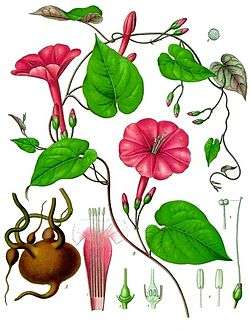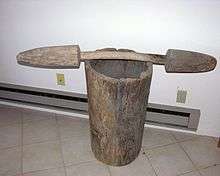Mojo (African-American culture)
Mojo /ˈmoʊdʒoʊ/, in the African-American folk belief called hoodoo, is an amulet consisting of a flannel bag containing one or more magical items. It is a "prayer in a bag", or a spell that can be carried with or on the host's body.
Alternative American names for the mojo bag include hand, mojo hand, conjure hand, lucky hand, conjure bag, trick bag, root bag, toby, jomo, and gris-gris bag.[1]
The term mojo is now commonly used in the English language to mean one's personal talent or gift. For example, a person might say that they are "getting their mojo on" when trying to get the attention of a possible mate.
Ideology
The most common synonym for the word mojo is gris-gris, which literally means "fetish" or "charm"; thus a gris-gris bag is a charm bag.[2] In the Caribbean, an almost identical African-derived bag is called a wanga or oanga bag, but that term is uncommon in the United States. The word conjure is an ancient alternative to "hoodoo", which is a direct variation of African-American folklore. Because of this, a conjure hand is also considered a hoodoo bag, usually made by a respected community conjure doctor.
The word hand in this context is defined as a combination of ingredients. The term may derive from the use of finger and hand bones from the dead in mojo bags, or from ingredients such as the lucky hand root (favored by gamblers). The latter suggests an analogy between the varied bag ingredients and the several cards that make up a hand in card games.[1] Mojo reaches as far back as West African culture, where it is said to drive away evil spirits, keep good luck in the household, manipulate a fortune, and lure and persuade lovers. The ideology of the ancestors and the descendants of the mojo hand used this "prayer in a bag" based on their belief of spiritual inheritance, by which the omniscient forefathers of their families would provide protection and favor, especially when they used the mojo. Through this, a strong belief was placed in the idealism of whomever used mojo, creating a spiritual trust in the magic itself.
Making
Although most Southern-style conjure bags are made of red flannel material, most seasoned conjurers use color symbolism. This practice embodies itself in the practice of hoodoo, in which green flannel is used for a money mojo, white flannel is used for a baby-blessing mojo, red flannel is used for love mojo, and so on. West Indians also use mojo bags but often use leather instead of flannel.
The contents of each bag vary directly with the aim of the conjurer. For example, a mojo carried for love-drawing will contain different ingredients than one for gambling luck or magical protection.[3] Ingredients can include roots, herbs, animal parts, minerals, coins, crystals, good luck tokens, and carved amulets. The more personalized objects are used to add extra power because of their symbolic value.
Maintenance
Fixing and feeding a mojo hand
There is a process to fixing a proper mojo. A ritual must be put in place in order to successfully prepare a mojo by being filled and awakened to life. This can be done by smoking incense and candles, or it may be breathed upon to bring it to life. Prayers may be said, and other methods may be used to accomplish this essential step. Once prepared, the mojo is "dressed" or "fed" with a liquid such as alcohol, perfume, water, or bodily fluids.[4] The reason it is said to feed the mojo to keep it working is that it is alive with spirit. One story from the work entitled From My People describes a slave who went out and sought a mojo conjurer that gave him a mojo to run away from home. The story describes the slave's mojo as fixing him into many formations, and he ultimately dies because he misuses its power.[5] Had he fixed and believed in the specific mojo himself, he might have escaped the plantation alive.
Hiding the mojo
Mojos are traditionally made for an individual and so must be concealed on the person at all times. Men usually keep the trinkets hidden in the pants pocket, while women are more prone to clip it to the bra. They are also commonly pinned to clothes below the waist. Depending on the type of mojo, the hiding place will be crucial to its success, as those who make conjure bags to carry love spells sometimes specify that the mojo must be worn next to the skin.[3] A story from the book From My People described the story of Moses and the task he went through to bring his people out of slavery. It described how "Hoodoo Lost his Hand", as Moses's mojo was hidden through his staff. When he turned it into a snake, the pharaoh made his soothsayers and magicians create the same effect. As a result, the Pharaoh's snake was killed by Moses's snake, and that is how Hoodoo lost his hand.[6]
References
- Bradley, Jude; Coen, Cheré Dastugue (2010). Magic's in the Bag: Creating Spellbinding Gris Gris and Sachets. Woodbury, Minnesota: Llewellyn.
- Knight, Jan (1980). A-Z of ghosts and supernatural. Pepper Press. p. 46. ISBN 0-560-74509-5.
- Whitten, Norman E., Jr. (1962). "Contemporary Patterns of Malign Occultism among Negroes in North Carolina." Journal of American Folklore 75.298: 312–318.
- Alvarado, D. (2011). The Voodoo Hoodoo Spellbook. San Francisco: Weiser Books.
- Brewer, Richard M. (1958). "The Mojo." From My People: 400 Years of African American Folklore. New York: Indiana University Press, 2002. pp. 47–48. Print.
- Brewer, Richard M. (1958). "How Hoodoo Lost His hand." From My People: 400 Years of African American Folklore. New York: Indiana University Press, 2002. pp. 63–64.

